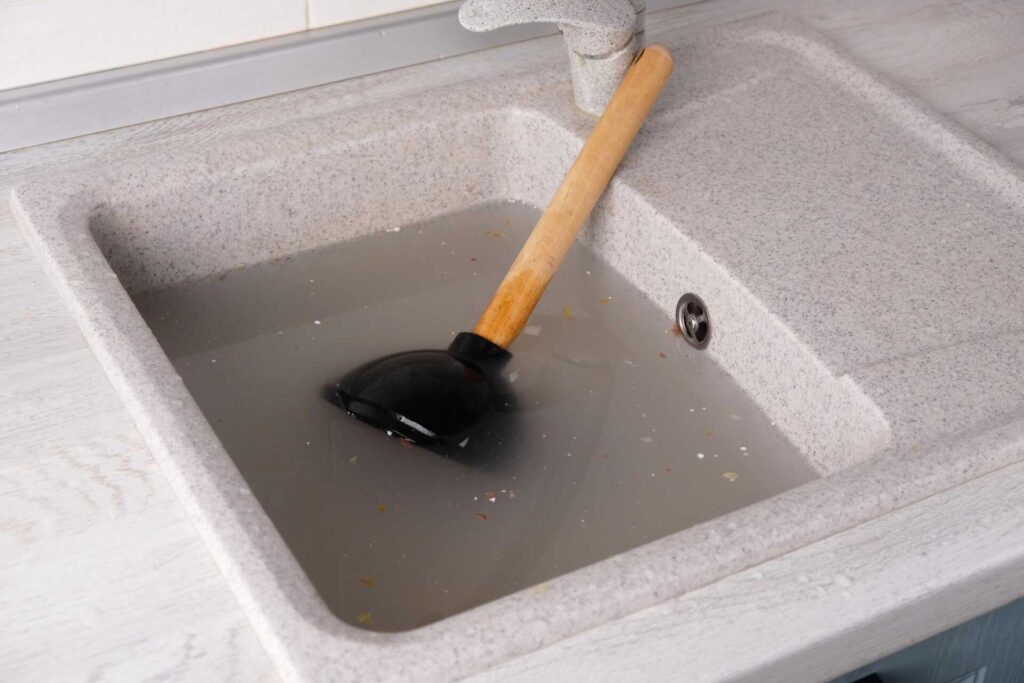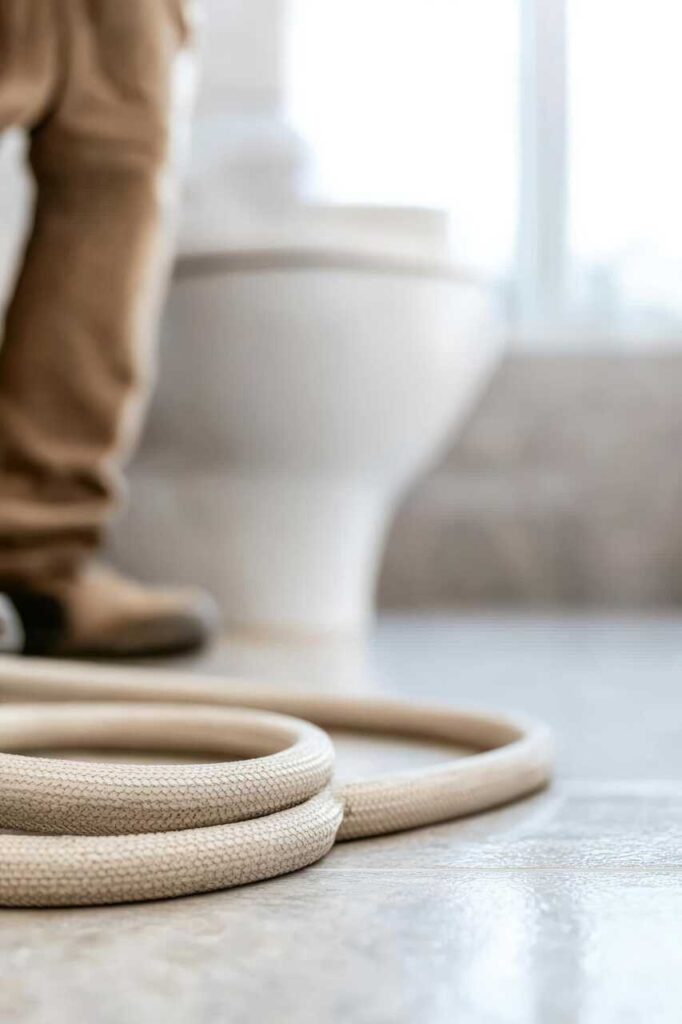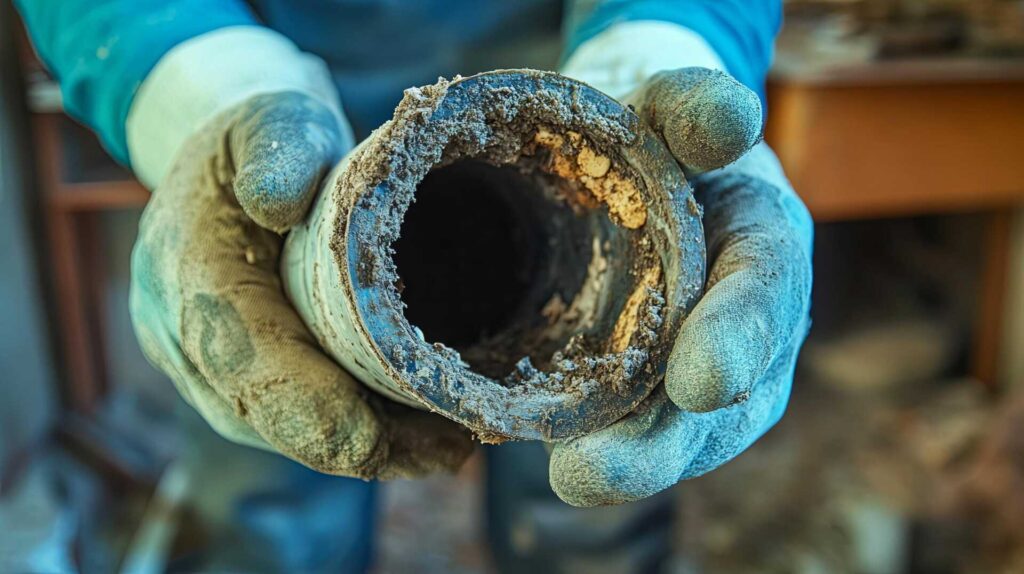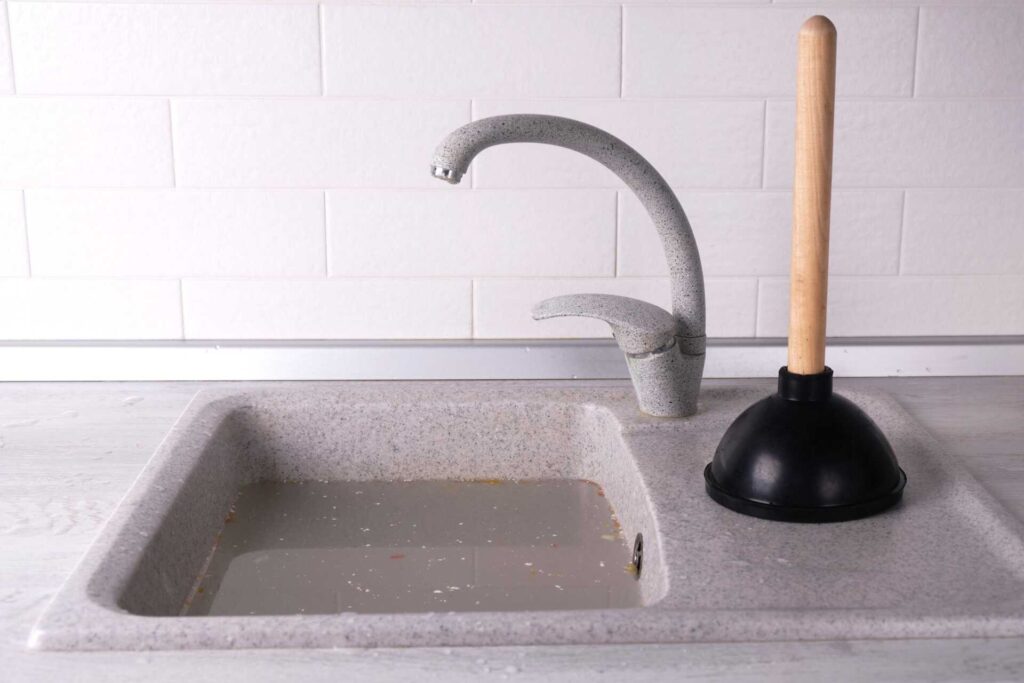
Contents
Like the mythical Hydra, a clogged pipe can sprout multiple issues if not addressed promptly. You might find yourself in a frustrating situation, wondering how to effectively tackle the problem without resorting to costly repairs. From simple tools like plungers and drain snakes to more advanced techniques such as hydro jetting, there are various solutions at your disposal. But how do you know which method is right for your specific clog? Let’s explore the top solutions to ensure your plumbing remains trouble-free.
Key Takeaways
- Use a cup or flange plunger to create a strong vacuum and dislodge minor clogs effectively.
- Employ a manual or electric drain snake to break up tougher blockages without damaging pipes.
- Combine baking soda and vinegar for an eco-friendly solution that can clear minor debris buildup.
- Consider hydro jetting for persistent clogs, as it uses high-pressure water to thoroughly clean pipes.
- Schedule regular maintenance and inspections with a professional plumber to prevent future clogs and ensure plumbing longevity.
Identify the Clog Source
Have you ever wondered what causes a clogged pipe? Understanding clog causes is essential for effective problem-solving. Typically, clogs result from a combination of hair, grease, soap residue, and foreign objects that accumulate over time. When you notice slow drainage or unpleasant odors, it’s a clear sign that a blockage is forming.
To tackle the issue, you’ll want to employ various identification methods. Start by visually inspecting the area around your sinks, showers, or toilets. Look for signs of overflow or water pooling. If you have access to cleanout plugs in your plumbing system, removing them can provide insight into where the clog might be. A flashlight can help you see deeper into the pipes.
Another effective method is to run hot water through the pipes, which can sometimes help dislodge minor blockages. Pay attention to any unusual sounds, like gurgling or bubbling, as they often indicate air trapped in the pipes due to a blockage. If you notice persistent issues, consider using a plumbing snake or auger, which can help you identify and break up tougher clogs.
Use a Plunger Effectively
A plunger is an indispensable tool for tackling minor clogs in your plumbing system. Knowing how to use it effectively can save you time and frustration. There are various plunger types, including the cup plunger and the flange plunger. The cup plunger is great for flat surfaces like sinks, while the flange plunger is designed for toilets, providing a better seal.
To start, place the plunger over the drain, ensuring it covers the opening completely. If you’re unclogging a sink, you may want to plug the overflow drain with a wet cloth to create a stronger vacuum. Next, grip the handle firmly and, with a steady motion, push down to create pressure, then pull up quickly. Repeat this action several times, maintaining a consistent rhythm. The key here is the proper technique—it’s about how hard you push and the suction you create.
After several thrusts, check if the water begins to drain. If it does, you’ve likely cleared the clog! If not, give it another round of plunging. Remember, patience is crucial during this process. If the clog persists, you may need to explore other methods.
Using a plunger effectively helps maintain your plumbing and reinforces your confidence in handling minor emergencies. With practice, you’ll become more adept, ensuring you’re well-prepared for any future plumbing challenges.
Try a Drain Snake
When you’re faced with a stubborn clog, a drain snake can be an effective solution. You can choose between manual operation techniques for smaller blockages or an electric drain snake for tougher jobs. Understanding how to use these tools will make clearing your pipes much easier and more efficient.
Manual Operation Techniques
Using a drain snake can be an effective way to tackle stubborn clogs in your pipes. This manual tool is a go-to for many DIY enthusiasts, allowing you to take control of your plumbing issues with confidence. Here’s a simple guide to help you use a drain snake effectively:
| Step | Action | Tip |
|---|---|---|
| 1 | Insert the snake into the drain | Make certain to push gently to avoid damaging the pipes. |
| 2 | Rotate the handle | This helps the snake to break through the clog. |
| 3 | Pull back the snake slowly | You’ll want to remove any debris that’s been collected. |
| 4 | Flush with water | Run hot water to ensure the drain is clear. |
Electric Drain Snake Benefits
While manual techniques like a drain snake can effectively clear clogs, electric drain snakes offer a range of advantages that make them a preferred choice for more challenging blockages. These powerful tools can tackle tough obstructions with ease, saving you time and effort. Unlike manual models, electric drains require less physical strength, allowing anyone to operate them comfortably.
Electric drain snakes come in various types, each designed for specific situations. For instance, some models are ideal for residential use, while others are built for commercial applications. With their rotating heads and high torque, electric snakes break up stubborn debris more efficiently than manual alternatives.
Moreover, using an electric drain snake means you can reach deeper into pipes, addressing clogs that manual snakes might miss. This capability reduces the need for multiple attempts, making your plumbing maintenance simpler and more effective.
Apply Baking Soda and Vinegar
Applying baking soda and vinegar can be an effective method for clearing clogged pipes due to their chemical reaction, which helps break down debris. To achieve the best results, follow a straightforward step-by-step application process that ensures proper mixing and timing. This natural solution unclogs and freshens your drains, making it a smart choice for maintenance.
Chemical Reaction Benefits
When you combine baking soda and vinegar, a powerful chemical reaction occurs that can effectively break down clogs in your pipes. This reaction produces carbon dioxide gas, which creates bubbles that help dislodge debris and buildup. In moments of plumbing emergencies, these natural ingredients offer a safe and eco-friendly alternative to harsh chemicals, allowing you to tackle clogs without risking damage to your pipes or the environment.
Using baking soda and vinegar as an emergency solution addresses immediate plumbing issues and promotes a healthier home. Unlike many commercial drain cleaners, which can contain toxic substances, this combination is safe for both you and your family. It’s an easy-to-source solution that fosters a sense of community, as many people share this simple trick passed down through generations.
Moreover, the effectiveness of this chemical reaction lies in its versatility. Whether you’re dealing with hair, grease, or food particles, baking soda and vinegar can break down various types of clogs. Embracing these natural emergency solutions empowers you to handle plumbing issues confidently and sustainably.
Step-by-Step Application
To effectively apply baking soda and vinegar for clearing clogs, start by gathering your materials: you’ll need about half a cup of baking soda, half a cup of vinegar, and a kettle of boiling water. This method is a great choice for emergency preparedness and routine pipe maintenance, ensuring your plumbing stays in good shape.
Begin by pouring the baking soda directly into the clogged drain. Make sure it’s evenly distributed to maximize its effectiveness. Next, follow up with the vinegar. You’ll notice a fizzing reaction; this is the chemical process working to break down the clog. Allow this mixture to sit for about 30 minutes. During this time, the baking soda and vinegar work to dissolve any buildup.
After 30 minutes, carefully pour the kettle of boiling water down the drain. This helps flush out the loosened debris. If the clog remains, you may need to repeat the process or consider additional methods. Regularly using this baking soda and vinegar technique can enhance your emergency preparedness and promote effective pipe maintenance, keeping your plumbing system functioning smoothly. Embrace these simple steps and feel empowered to tackle clogs confidently!
Utilize Hydro Jetting
If you’re dealing with persistent clogs that traditional methods can’t clear, utilizing hydro jetting may be your best bet. This advanced technique employs high-pressure water jets to thoroughly cleanse your pipes, making it an effective solution for even the toughest blockages. Understanding the hydro jetting process and its benefits can help you decide if it’s the right choice for your situation.
Here are three key hydro jetting benefits:
Complete Cleaning: Hydro jetting removes all types of buildup, including grease, tree roots, and mineral deposits, ensuring your pipes are as clean as they can be. This thorough cleaning can greatly reduce the likelihood of future clogs.
Environmentally Friendly: Unlike chemical cleaners, hydro jetting uses only water. This makes it a safer option for both your plumbing system and the environment, as it doesn’t introduce harmful substances into your home or the ecosystem.
Cost-Effective: While the initial investment might be higher than traditional methods, hydro jetting can save you money in the long run. By preventing future clogs and the associated repair costs, it proves to be a smart choice.
Call Professional Services
Sometimes, tackling clogged pipes on your own can lead to more frustration than results. While DIY methods might seem appealing, they often lack the effectiveness and safety that come from professional intervention. When you face a plumbing emergency, calling in professional services can save you time, stress, and potential damage to your home.
Professional plumbers are equipped with the right tools and expertise to handle complex clogs efficiently. They provide emergency response, ensuring that your issue is addressed promptly before it escalates into a more significant problem. Unlike temporary fixes, these experts focus on long-term solutions that restore your plumbing system’s functionality.
Service reliability is another critical aspect of hiring professional help. You can trust that licensed plumbers adhere to industry standards and regulations, providing you with peace of mind. Their experience allows them to diagnose issues accurately and recommend the best course of action. This means you can avoid the trial-and-error that often comes with DIY attempts.
Moreover, working with professionals fosters a sense of belonging to a community that prioritizes safety and efficiency. You’re not just hiring a service; you’re partnering with skilled individuals who understand the intricacies of plumbing and are committed to helping you. So, the next time you’re faced with a clogged pipe emergency, remember that calling professional services is often the best choice for a reliable, effective resolution. Your home deserves the best care, and these experts are ready to provide it.
Inspect With a Camera
How can you truly understand the extent of a clog without a thorough inspection? Utilizing advanced camera technology for pipe inspection can provide you with unparalleled insights into your plumbing system. This method allows you to pinpoint the problem area and assess the severity of the clog, ensuring you take the right steps toward resolution.
Here are three key inspection benefits you can experience by opting for camera inspections:
Visual Clarity: With a camera, you can see exactly what’s causing the blockage. This eliminates guesswork and helps you avoid unnecessary repairs.
Time Efficiency: Camera inspections are quick. Instead of spending hours digging or disassembling pipes, you can get instant feedback on the situation, saving you time and hassle
Cost-Effectiveness: By accurately identifying the issue, you can address it promptly and effectively, potentially avoiding more expensive repairs down the line.
Maintain Regular Drain Cleaning
After gaining insights from a camera inspection, maintaining regular drain cleaning becomes an essential step in preventing future clogs. You might not realize it, but the health of your plumbing system directly impacts your home’s comfort and functionality. Regular drain maintenance is important to ensure that debris, grease, and other buildup don’t accumulate in your pipes over time.
Schedule routine inspections with a professional plumber who can identify potential issues early on. These regular inspections help spot clogs and allow for proactive cleaning, which can save you from significant headaches down the line. By investing in regular drain cleaning, you’re taking a critical step towards safeguarding your home against unforeseen plumbing emergencies.
You’ll also want to be mindful of what goes down your drains. Simple changes, like using drain screens or avoiding pouring grease down the sink, can go a long way in reducing the need for extensive cleaning. Communicate with your family about these practices to create a culture of care and responsibility regarding your home’s plumbing.
In addition to maintaining your drains, fostering a relationship with a trusted plumber can provide peace of mind. They can offer tailored advice on your specific system and help you establish a cleaning schedule that suits your needs. By prioritizing regular drain cleaning, you’re not just preventing clogs; you’re investing in the longevity of your plumbing system and the overall well-being of your home.
Know When to Replace Pipes
Recognizing the signs that indicate it’s time to replace your pipes is essential for maintaining a healthy plumbing system. Over time, pipes can degrade due to factors like pipe age and the material types used in their construction. Ignoring these signs can lead to more significant issues, including costly repairs and water damage. Here are three key indicators that it might be time to evaluate a replacement:
Frequent Leaks: If you’re constantly dealing with leaks, it’s a clear signal that your pipes are nearing the end of their lifespan. Older pipes, especially those made from materials like galvanized steel or polybutylene, are more prone to leaks and require immediate attention.
Discolored Water: If your water looks brown or rusty, it could be due to corroded pipes. This discoloration indicates that your pipes are deteriorating and may pose health risks if not addressed.
Low Water Pressure: A sudden drop in water pressure can arise from clogs or pipe damage. If regular cleaning doesn’t resolve the issue, your pipes may need replacing.
Review
In the journey of maintaining your home’s plumbing, think of yourself as a vigilant gardener. Just as a garden flourishes with regular care, your pipes thrive with consistent maintenance. Address clogs promptly, wield your tools like a skilled craftsman, and don’t hesitate to seek professional help when needed. By nurturing your plumbing system, you prevent roots of trouble from taking hold, ensuring a smooth flow that waters the seeds of comfort and convenience in your daily life.



